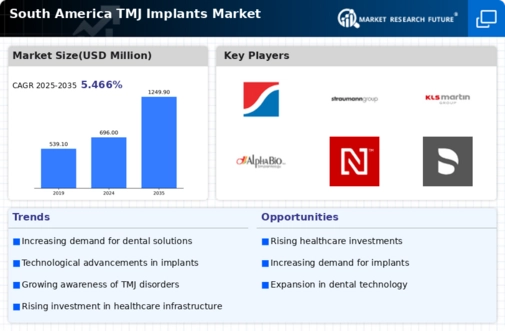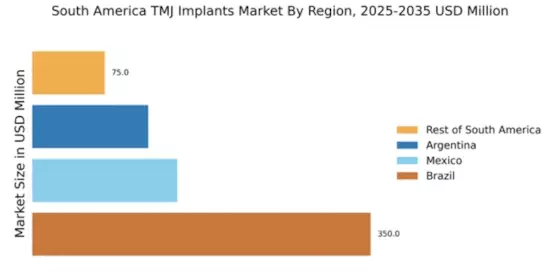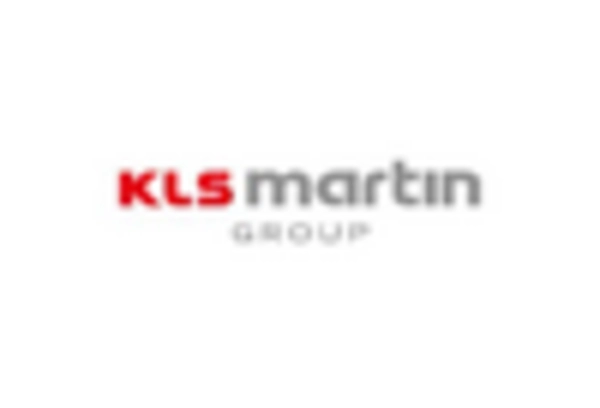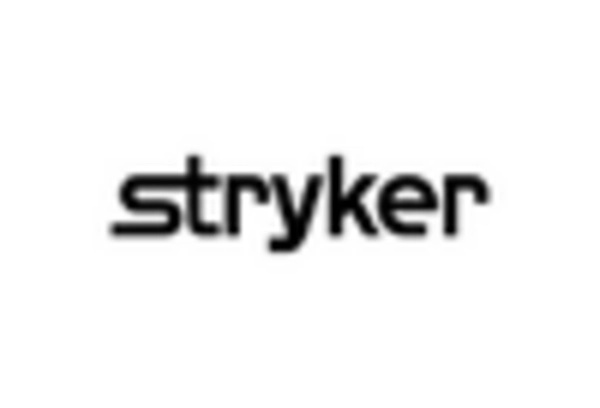Rising Disposable Incomes
The increase in disposable incomes across South America is positively impacting the TMJ implants market. As individuals experience improved financial conditions, they are more inclined to invest in their health and well-being. This trend is particularly relevant for elective procedures, such as TMJ implant surgeries, which may not be covered by insurance. The willingness to pay for advanced treatment options is expected to drive market growth, with an estimated increase of 7% in demand for TMJ implants over the next few years. This economic shift suggests a growing recognition of the importance of addressing TMJ disorders, further fueling the market.
Advancements in Surgical Techniques
Innovations in surgical techniques for TMJ implants are significantly influencing the market in South America. Minimally invasive procedures, such as arthroscopy, have gained traction, allowing for reduced recovery times and improved patient outcomes. These advancements not only enhance the effectiveness of TMJ implants but also attract more patients seeking surgical intervention. The introduction of robotic-assisted surgeries and 3D printing technology further streamlines the implant manufacturing process, ensuring precision and customization. As a result, the TMJ implants market is likely to experience a surge in demand, with an anticipated growth rate of 8% annually over the next five years. This evolution in surgical practices is pivotal for the future of TMJ treatment.
Increasing Prevalence of TMJ Disorders
The rising incidence of temporomandibular joint (TMJ) disorders in South America is a crucial driver for the TMJ implants market. Factors such as stress, poor posture, and dental issues contribute to this increase. Recent studies indicate that approximately 10-15% of the population experiences TMJ-related symptoms, leading to a growing demand for effective treatment options. As awareness of these disorders expands, patients are more likely to seek medical intervention, thereby propelling the market for TMJ implants. The need for surgical solutions is expected to rise, with the market projected to reach a valuation of $200 million by 2027. This trend underscores the importance of addressing TMJ disorders through innovative implant solutions.
Growing Investment in Healthcare Infrastructure
The expansion of healthcare infrastructure in South America is a vital driver for the TMJ implants market. Governments and private entities are increasingly investing in healthcare facilities, enhancing access to advanced medical treatments. This investment is particularly evident in urban areas, where specialized clinics for TMJ disorders are emerging. Improved healthcare access is likely to lead to higher diagnosis rates and, consequently, an increased demand for TMJ implants. The market is projected to grow by 6% annually, reaching approximately $150 million by 2026. Enhanced healthcare infrastructure not only facilitates better patient care but also encourages the adoption of innovative implant technologies.
Enhanced Patient Education and Awareness Programs
The implementation of patient education and awareness programs in South America is a significant driver for the TMJ implants market. Healthcare providers are increasingly focusing on informing patients about TMJ disorders, their symptoms, and available treatment options. These initiatives aim to empower patients to seek timely medical attention, thereby increasing the likelihood of surgical interventions. As awareness grows, the demand for TMJ implants is expected to rise, with projections indicating a market growth of 5% annually. Enhanced education not only facilitates early diagnosis but also fosters a more informed patient base, ultimately benefiting the overall healthcare landscape.


















Leave a Comment